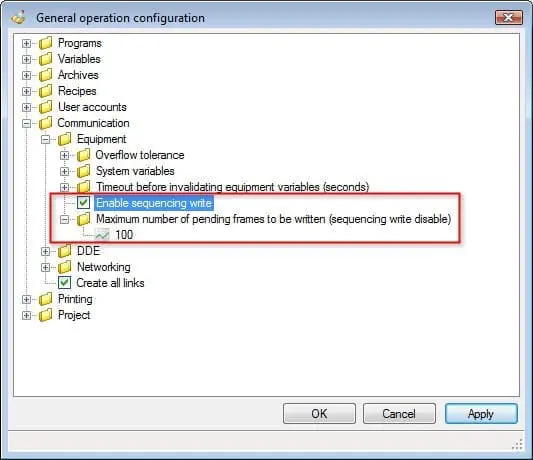| Applies to:
PcVue from version 7.20a. |
||||||||||||||||||||||||||||||||||||||||||||||||||||||||||||||||||||||||||||||||||||||||||||||||||||||||||||||||||||||||||||||||||||||
|
|
||||||||||||||||||||||||||||||||||||||||||||||||||||||||||||||||||||||||||||||||||||||||||||||||||||||||||||||||||||||||||||||||||||||
| Summary:
This article explains how to diagnose a bottleneck of Write requests from the EQT Manager to CimWay. |
||||||||||||||||||||||||||||||||||||||||||||||||||||||||||||||||||||||||||||||||||||||||||||||||||||||||||||||||||||||||||||||||||||||
|
|
||||||||||||||||||||||||||||||||||||||||||||||||||||||||||||||||||||||||||||||||||||||||||||||||||||||||||||||||||||||||||||||||||||||
| Details:
The properties that control the general operation of the Supervisor’s native communication drivers are as follows. Property: ‘Enable sequencing Write’ In versions 7.20 and earlier, the sequencing of write requests was always enabled. The process is as follows.
In versions 7.20a and later write sequencing is not enabled by default. In this case EQT Manager processes the Write requests in parallel for each device in a non-blocking mode, i.e. the Manager does not wait for the replies. Property: ‘Maximum number of pending frames’ This property is used when the sequencing of write requests is disabled. The default value is 100. If the number of write requests (per equipment) that are waiting is higher than that, error message number 4534 appears in the Event Viewer: CW , Number of Write requests in progress is too large If the number of Write requests waiting is more than 10 times this number then error message 4578 appears in the Event Viewer: CW , Number of Write requests in progress is too large (NACK) and the Write request is abandoned. Accessing these properties In versions before 8.10 these properties are found in the Communication Options dialog ( Configuration > Communication > General Operation) In versions 8.10 and later these properties are found in the Communications folder of the General Operations dialog (Configuration > Project > General operation)
In versions supporting the Application Explorer these properties are found in Settings > Advanced > Communication > Equipment. Flow and message counters available in the Audit files Flow and counter of the number of writes on a single equipment variable This relates to the user action on Send animations on variables and the forcing of variables from SCADA BASIC and from VB/VBA. EQT WRITE 0 3__base 10 6 __ 21/12 07:13:01 4 __ 21/12 07:13:12 3 __ 21/12 07:13:23 3 __ 21/12 07:13:34 3 __ 21/12 07:13:45
EQT Write 205 20763 205 1 0 0 2 0 0 3 205 20763 4 0 0 The first column represents the type of variable: 1 – Bit. The line for the register variable shows that there are 205 Write requests waiting. Flow and counters on the number of recipes sent This relates to the Send Recipe requests from the Recipe module or from the SENDLIST instruction in SCADA BASIC.
The first column represents the type of recipe. 1 – Block mode In this example there are five recipes waiting, one in block mode and four in multiple Mode. Flow and counter for the number of frame write requests to Cimway from the EQT manager
The first column shows the command type: 1 – Write a single variable In this example, there are 205 Write requests waiting for a particular variable but none for multiple variables. Message counter for messages waiting in the manager’s mailbox
The first column represents the EQT Manager. 0 – Startup In this example, there are 206 messages waiting in the EQT Manager. If sequencing of Write requests is enabled and there are too many Write requests, this counter will increase (normally it should be at or around 0). Then the counters for Cimway write, EQT write and Recipe write should be examined. |
||||||||||||||||||||||||||||||||||||||||||||||||||||||||||||||||||||||||||||||||||||||||||||||||||||||||||||||||||||||||||||||||||||||
|
|
||||||||||||||||||||||||||||||||||||||||||||||||||||||||||||||||||||||||||||||||||||||||||||||||||||||||||||||||||||||||||||||||||||||
|
Created on: 16 Feb 2010 Last update: 13 May 2024
